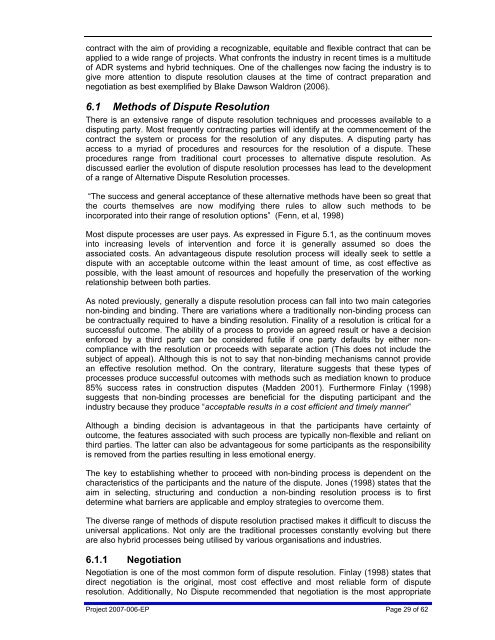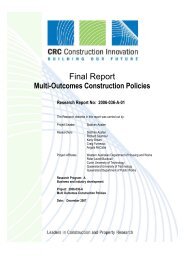Dispute Avoidance and Resolution (literature review) - Construction ...
Dispute Avoidance and Resolution (literature review) - Construction ...
Dispute Avoidance and Resolution (literature review) - Construction ...
You also want an ePaper? Increase the reach of your titles
YUMPU automatically turns print PDFs into web optimized ePapers that Google loves.
contract with the aim of providing a recognizable, equitable <strong>and</strong> flexible contract that can beapplied to a wide range of projects. What confronts the industry in recent times is a multitudeof ADR systems <strong>and</strong> hybrid techniques. One of the challenges now facing the industry is togive more attention to dispute resolution clauses at the time of contract preparation <strong>and</strong>negotiation as best exemplified by Blake Dawson Waldron (2006).6.1 Methods of <strong>Dispute</strong> <strong>Resolution</strong>There is an extensive range of dispute resolution techniques <strong>and</strong> processes available to adisputing party. Most frequently contracting parties will identify at the commencement of thecontract the system or process for the resolution of any disputes. A disputing party hasaccess to a myriad of procedures <strong>and</strong> resources for the resolution of a dispute. Theseprocedures range from traditional court processes to alternative dispute resolution. Asdiscussed earlier the evolution of dispute resolution processes has lead to the developmentof a range of Alternative <strong>Dispute</strong> <strong>Resolution</strong> processes.“The success <strong>and</strong> general acceptance of these alternative methods have been so great thatthe courts themselves are now modifying there rules to allow such methods to beincorporated into their range of resolution options” (Fenn, et al, 1998)Most dispute processes are user pays. As expressed in Figure 5.1, as the continuum movesinto increasing levels of intervention <strong>and</strong> force it is generally assumed so does theassociated costs. An advantageous dispute resolution process will ideally seek to settle adispute with an acceptable outcome within the least amount of time, as cost effective aspossible, with the least amount of resources <strong>and</strong> hopefully the preservation of the workingrelationship between both parties.As noted previously, generally a dispute resolution process can fall into two main categoriesnon-binding <strong>and</strong> binding. There are variations where a traditionally non-binding process canbe contractually required to have a binding resolution. Finality of a resolution is critical for asuccessful outcome. The ability of a process to provide an agreed result or have a decisionenforced by a third party can be considered futile if one party defaults by either noncompliancewith the resolution or proceeds with separate action (This does not include thesubject of appeal). Although this is not to say that non-binding mechanisms cannot providean effective resolution method. On the contrary, <strong>literature</strong> suggests that these types ofprocesses produce successful outcomes with methods such as mediation known to produce85% success rates in construction disputes (Madden 2001). Furthermore Finlay (1998)suggests that non-binding processes are beneficial for the disputing participant <strong>and</strong> theindustry because they produce “acceptable results in a cost efficient <strong>and</strong> timely manner”Although a binding decision is advantageous in that the participants have certainty ofoutcome, the features associated with such process are typically non-flexible <strong>and</strong> reliant onthird parties. The latter can also be advantageous for some participants as the responsibilityis removed from the parties resulting in less emotional energy.The key to establishing whether to proceed with non-binding process is dependent on thecharacteristics of the participants <strong>and</strong> the nature of the dispute. Jones (1998) states that theaim in selecting, structuring <strong>and</strong> conduction a non-binding resolution process is to firstdetermine what barriers are applicable <strong>and</strong> employ strategies to overcome them.The diverse range of methods of dispute resolution practised makes it difficult to discuss theuniversal applications. Not only are the traditional processes constantly evolving but thereare also hybrid processes being utilised by various organisations <strong>and</strong> industries.6.1.1 NegotiationNegotiation is one of the most common form of dispute resolution. Finlay (1998) states thatdirect negotiation is the original, most cost effective <strong>and</strong> most reliable form of disputeresolution. Additionally, No <strong>Dispute</strong> recommended that negotiation is the most appropriateProject 2007-006-EP Page 29 of 62
















